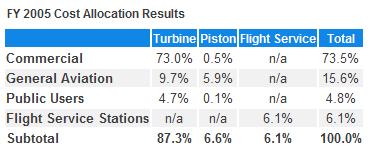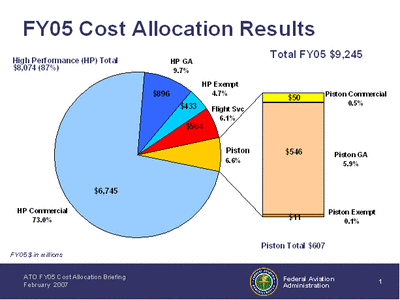Wed, Feb 14, 2007
Agency Worked With National Accounting Firm To Determine
Allocations
 How did the Federal Aviation
Administration arrive at its decision to increase fees operators of
smaller aircraft would pay under its proposed new funding scheme?
The FAA states it worked with accounting firm
PriceWaterhouseCoopers to designed what the agency calls "a simple,
transparent, thorough, and repeatable cost allocation
methodology."
How did the Federal Aviation
Administration arrive at its decision to increase fees operators of
smaller aircraft would pay under its proposed new funding scheme?
The FAA states it worked with accounting firm
PriceWaterhouseCoopers to designed what the agency calls "a simple,
transparent, thorough, and repeatable cost allocation
methodology."
The FAA used FY 2005 Cost Accounting System data -- which the
agency says is the most detailed and comprehensive cost data
available as the proposal was being developed -- to distinguish
between two types of users:
- Turbine-powered aircraft (jets and turboprops)
users drive most system costs because they fly in all weather, at
all times of the day, tend to be time-sensitive, generally compete
for the same air traffic control resources, and require complex air
traffic equipment and procedures.
- Piston aircraft and helicopter users, who
typically fly lower and slower than turbine pilots. These aircraft
typically fly less complex equipment, tend to be less time
sensitive, frequently fly under visual flight rules, and require
different types of air traffic control resources.
The FAA allocated the costs of more than 600 Cost Accounting
System projects between these two user types and determined that,
in most cases, piston users were responsible for only a share of
incremental costs. The total FY 2006 air traffic costs were
allocated as follows:

- 87% to turbine users,
- 7% to piston users, and
- 6% to flight service stations (expected to decline in future
years).
Within each group, the FAA divided costs among commercial,
general aviation and public users based on their share of activity.
In the terminal environment, the allocation looks at costs and
activity within groups of similarly-sized airports. As a result,
users of less costly facilities do not bear the costs of more
expensive facilities.
This table summarizes the FY 2005 cost allocation results,
according to the FAA:

Flight Service Station costs are not allocated among users,
because costs are expected to decline substantially in future years
(one assumes, due to increased privitization of the service --
Ed.) and the cost recovery proposal funds these costs from the
General Fund.
More News
Also: New Lakeland Fly-in!, Gleim's DPE, MOSAIC! Nearly three-quarters of a century in the making, EAA is excited about the future… especially with the potential of a MOSAIC>[...]
Estimated (EST) -When used in NOTAMs “EST” is a contraction that is used by the issuing authority only when the condition is expected to return to service prior to the >[...]
Aero Linx: Regional Airline Association (RAA) Regional airlines provide critical links connecting communities throughout North America to the national and international air transpo>[...]
The Airplane Broke Up In Flight And Descended To The Ground. The Debris Path Extended For About 1,435 Ft. Analysis: The pilot, who was the owner and builder of the experimental, am>[...]
From 2015 (YouTube version): History Comes Alive Thanks to A Magnificent CAF Effort The story of the Douglas C-47 named, “That’s all Brother,” is fascinating from>[...]
 Airborne 07.21.25: Nighthawk!, Hartzell Expands, Deltahawk 350HP!
Airborne 07.21.25: Nighthawk!, Hartzell Expands, Deltahawk 350HP! ANN's Daily Aero-Term (07.27.25): Estimated (EST)
ANN's Daily Aero-Term (07.27.25): Estimated (EST) ANN's Daily Aero-Linx (07.27.25)
ANN's Daily Aero-Linx (07.27.25) NTSB Final Report: Luce Buttercup
NTSB Final Report: Luce Buttercup Classic Aero-TV: 'That's All Brother'-Restoring a True Piece of Military History
Classic Aero-TV: 'That's All Brother'-Restoring a True Piece of Military History





